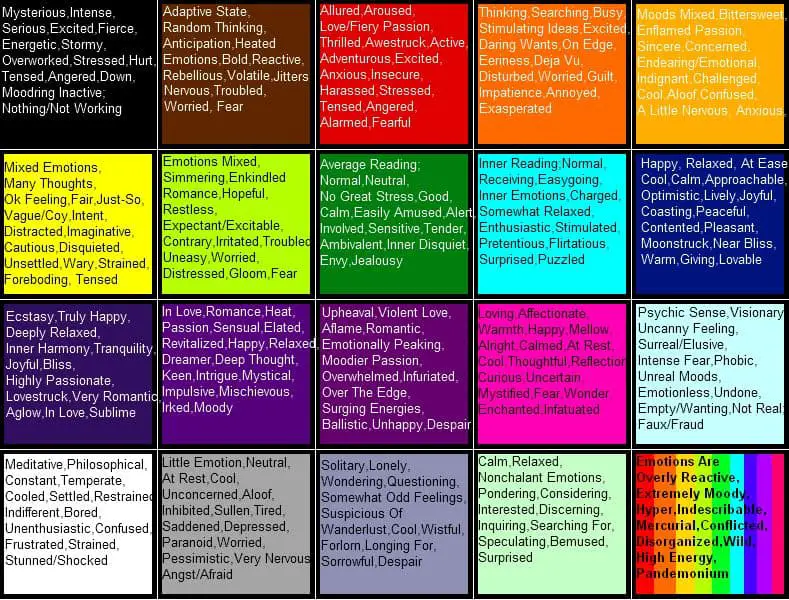Mood rings, those nostalgic accessories that purportedly reflect the wearer’s emotional state, have captivated imaginations for decades. While the accuracy of their purported mind-reading abilities remains a topic of debate, the color transformations they undergo provide a fascinating glimpse into thermochromic technology and the subjective interpretation of emotional states. Among the spectrum of hues displayed by a mood ring, the color purple holds a particularly intriguing position. Let’s delve into the multifaceted meanings associated with purple in the context of these enigmatic adornments.
The General Interpretation of Purple in Mood Rings
Generally, when a mood ring turns purple, it is often interpreted as signifying a state of equilibrium, contentment, or even infatuation. This color suggests a harmonious blend of emotions, where the wearer is experiencing a sense of calm serenity combined with a touch of romanticism.
Purple as a Sign of Happiness and Joy
In some interpretations, a vibrant, lighter shade of purple can denote happiness and a sense of joie de vivre. This suggests an elevated mood, brimming with positive energy and an optimistic outlook. It’s a state where the wearer feels buoyant and emotionally uplifted. Moreover, it’s indicative of emotional stability.
Purple as Indicative of Romantic Feelings
Perhaps one of the most common associations with purple in mood rings is the presence of romantic feelings. This could range from a simple fondness for someone to a deep, passionate affection. The wearer may be experiencing feelings of love, desire, or strong attraction. The specific nuance of the romantic feeling can often be inferred from the shade of purple; a lighter purple might indicate a burgeoning crush, while a deeper, richer purple suggests a more profound emotional connection.
Purple as a Sign of Creativity and Intuition
Beyond romantic connotations, purple can also signify heightened creativity and intuition. This color is often linked to the realm of imagination, spiritual awareness, and a deeper connection to one’s inner self. A purple mood ring might indicate that the wearer is feeling inspired, imaginative, and attuned to their subconscious. Furthermore, it may suggest they are open to new ideas and possess a heightened sense of perception.
The Subtleties of Different Shades of Purple
It’s important to acknowledge that the specific shade of purple displayed by a mood ring can further refine the interpretation of its meaning. As alluded to earlier, lighter purples may lean towards feelings of lightness and joy, while darker purples might indicate a more intense emotional experience.
Light Purple (Lavender or Lilac): These gentler hues are often associated with calmness, tranquility, and a sense of peace. They suggest a delicate emotional state, free from intense or overwhelming feelings. The wearer may be feeling relaxed and content in their current surroundings.
Medium Purple: A standard purple shade generally represents the balanced interpretation of contentment, happiness, and emerging romantic feelings. It’s a stable emotional state and may be more indicative of the ring functioning correctly. It indicates the presence of the baseline mood and overall emotional health.
Dark Purple (Indigo or Violet): These deeper shades of purple can signify a more intense emotional experience, potentially bordering on passion, heightened intuition, or even a touch of melancholy. The wearer might be feeling deeply connected to their emotions or experiencing a profound sense of introspection. It can also signal a contemplative mood, where the individual is delving into their thoughts and feelings with greater intensity.
Factors Influencing the Accuracy of Mood Ring Readings
It’s crucial to remember that mood rings are primarily novelty items, and their accuracy in reflecting actual emotional states is questionable at best. The thermochromic liquid crystals within the ring react to changes in temperature, which are influenced not only by the wearer’s body temperature but also by the ambient temperature of the surroundings. Therefore, external factors can significantly impact the color displayed by the ring, leading to potentially misleading interpretations.
Ambient Temperature: A cold environment can cause the ring to display colors associated with stress or anxiety, while a warm environment may lead to colors associated with happiness or excitement, regardless of the wearer’s actual emotional state.
Individual Body Temperature: Metabolic rate, physical activity, and even clothing can influence body temperature, thereby affecting the color of the mood ring. An individual with a naturally higher body temperature may consistently display colors associated with positive emotions, while someone with a lower body temperature might see colors associated with negative emotions more frequently.
Ring Quality and Condition: The quality of the thermochromic liquid crystals and the overall condition of the ring can also impact its accuracy. Over time, the liquid crystals can degrade, leading to inaccurate or inconsistent color changes.
Conclusion
While the color purple in a mood ring is generally interpreted as a sign of happiness, love, creativity, or intuition, it’s essential to consider the specific shade of purple and the influence of external factors on the ring’s color. Ultimately, mood rings are best viewed as fun and whimsical accessories rather than reliable indicators of emotional states. The subjective interpretation of colors and emotions adds to their charm, allowing individuals to project their own feelings and experiences onto these nostalgic trinkets. Whether you believe in their purported powers or simply enjoy their aesthetic appeal, mood rings remain a fascinating artifact of pop culture, inviting us to contemplate the complexities of human emotion and the ever-elusive quest to understand ourselves.







Leave a Comment